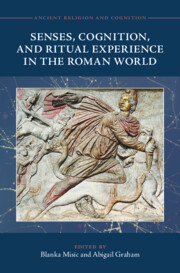Book contents
- Senses, Cognition, and Ritual Experience in the Roman World
- Ancient Religion and Cognition
- Senses, Cognition, and Ritual Experience in the Roman World
- Copyright page
- Contents
- Figures
- Contributors
- Acknowledgements
- Abbreviations
- Introduction Experiencing Rituals
- Chapter 1 Remembering the Rites: Religious Learning Network Model and Transmission of Religious Rituals in the Worship of Nutrices Augustae (Poetovio, Pannonia Superior)
- Chapter 2 The Haptic Production of Religious Knowledge among the Vestal Virgins: A Hands-On Approach to Roman Ritual
- Chapter 3 Haptic Colour: Experiential Viewing in Graeco-Roman Sacred Spaces
- Chapter 4 Nobody Is Gonna Rain on My Parade: Experiencing Salutaris’s Procession As a Ritual Event
- Chapter 5 Objects and Ritual in Egeria’s Fourth-Century Pilgrimage: The Props of My Faith
- Conclusion (Re)Creating Ritual Experiences
- Index
- References
Conclusion - (Re)Creating Ritual Experiences
Published online by Cambridge University Press: 04 January 2024
- Senses, Cognition, and Ritual Experience in the Roman World
- Ancient Religion and Cognition
- Senses, Cognition, and Ritual Experience in the Roman World
- Copyright page
- Contents
- Figures
- Contributors
- Acknowledgements
- Abbreviations
- Introduction Experiencing Rituals
- Chapter 1 Remembering the Rites: Religious Learning Network Model and Transmission of Religious Rituals in the Worship of Nutrices Augustae (Poetovio, Pannonia Superior)
- Chapter 2 The Haptic Production of Religious Knowledge among the Vestal Virgins: A Hands-On Approach to Roman Ritual
- Chapter 3 Haptic Colour: Experiential Viewing in Graeco-Roman Sacred Spaces
- Chapter 4 Nobody Is Gonna Rain on My Parade: Experiencing Salutaris’s Procession As a Ritual Event
- Chapter 5 Objects and Ritual in Egeria’s Fourth-Century Pilgrimage: The Props of My Faith
- Conclusion (Re)Creating Ritual Experiences
- Index
- References
Summary
How can we use cognitive approaches to embed the dynamic and often variant outcomes of ritual experiences? Key themes that have emerged in both individual and communal rituals are the subjectivity and variation in these experiences: the role of physical and emotional interaction in shaping memory. The concluding chapter begins with a vivid discussion of cognition, sensation and experience, exploring how these elements function together, creating a spectrum of variable experiences and outcomes in modern and ancient ritual contexts. This section is used to further develop ideas, common themes and issues connecting the different chapters – the versatility of ritual experience(s), the role of embodied cognition in constructing ritual experience(s), the importance of the relationship between distributed cognition and ritual experience(s) - and how these themes help to expand disciplinary boundaries in the study of ancient religions and religious rituals. The concluding chapter also situates the themes of the volume within current cognitive science of religion research as well as broader disciplines such as art, heritage and museum studies. These discussions address how the study of ancient religions from a cognitive perspective can contribute to a number of disciplines, opening up new venues for research and interdisciplinary collaboration.
Keywords
- Type
- Chapter
- Information
- Senses, Cognition, and Ritual Experience in the Roman World , pp. 200 - 224Publisher: Cambridge University PressPrint publication year: 2024



